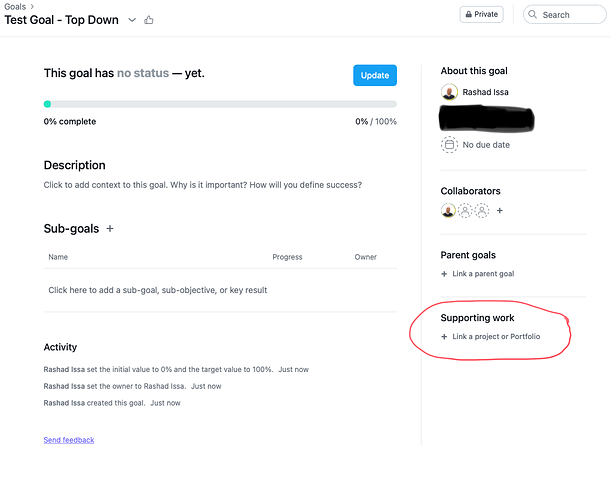Whether you are an SME (small-medium enterprise) or a large organisation, whether you are co-located ![]() , or spread around the globe
, or spread around the globe ![]() , if you use asana, it is probably because you want to enhance productivity
, if you use asana, it is probably because you want to enhance productivity ![]() and increase collaboration:blonde_woman:
and increase collaboration:blonde_woman:![]()
![]() .
.
Most importantly, it is because you are trying to achieve something that is part of a bigger picture.
![]() So the question is: what is this bigger picture?
So the question is: what is this bigger picture?
Asana has introduced Goals a while back and talked about the Pyramid of Clarity. Your Guide to Creating a Pyramid of Clarity with Goals in Asana - Inside Asana • Asana
Let us put this into practice. Whether you are brand new to asana and Goals is a feature you access from day 1, or whether you have used asana for a while and recently upgraded to enjoy this feature. Here are few things to consider that will make this feature work:
![]() **Top Down Strategy:**
**Top Down Strategy:**![]()
- This usually happens when the exec team set clear high level strategic goals that the company needs to achieve.
- Take note of these initiatives, and enter them one by on within Goals
- Work with all the executive team to ensure each goal is defined and has a measurable metric.
- Set the acceptable time frame, frequency of updates and any high level priority metric you want to bring forward to the page
I attached couple of pictures to show you what a goal would look like. My metric is set for percentage and an update is expected on monthly basis.
Why is this a top down approach? Because the goals are built first and then you can decide how to cascade this down to the teams, and give them the ability to link their work (i.e. the different projects and portfolios) to be linked to this goal. You can see the supporting work is left blank until you engage with your team and clearly map out the work.
![]() ***Bottom up Approach:***
***Bottom up Approach:***![]()
- You got the high level direction from the executive team (or yourself .. you mapped out your high level direction for the year)
- Generally speaking, this direction does not all kick off from scratch. You will find that there is a percentage of the direction that is dictated by some of the work you are already doing. This work is represented in some of the projects that are active in Asana
- Note down a list of all the active projects you are working on
- Note down all the initiatives that you will start working on based on the high level direction you are aiming at
For your strategy to stick, make sure it is simple and easy to follow. I find that categorising your strategy into areas will help you simplify things.
Find common themes in each of the areas and and come up with a headline to explain it.
Now that is ready, make that headline your Goal on asana, link all active projects to this goal and work with everyone to set expectations, frequency of updates, ownership, metrics, etc..
And because you are still reading, here is a practical tip that always works for me and is very much an asana tip:
![]()
![]() Create a project in Asana and make it your strategy project.. Use it as your notepad to finalise all the discussion and do all the categorising, brain storming and planning. Once the picture is clear for you, go on and build these goals within Asana Goals feature. This is useful because it is very rare that your strategy is readily outlined from one go. So it saved you from changing the goals set up and only build them up when you are all set to go.
Create a project in Asana and make it your strategy project.. Use it as your notepad to finalise all the discussion and do all the categorising, brain storming and planning. Once the picture is clear for you, go on and build these goals within Asana Goals feature. This is useful because it is very rare that your strategy is readily outlined from one go. So it saved you from changing the goals set up and only build them up when you are all set to go.
This also helps me because sometimes certain goals may not have direct active projects associated with them, but you still need to put it at the centre of your strategy. Having that clarity will help you map these ones ut too.
It is difficult to demo bottom up approach in screen shots, but I am happy to provide guidance or have a chat if you have any questions.
I hope this helps. How do you use ![]() Goals?
Goals?
Rashad

